Where Are We Going?
Crossroads Stories – East L.A.
Gentrification is the process by which a neighborhood changes through the influx of affluent residents and businesses. These newcomers cause rent prices to rise, often displacing local families and establishments. As more investment and people move into cities, gentrification is a concern in neighborhoods worldwide. In East L.A., people have protested and taken action to counter the effects of gentrification on their community.
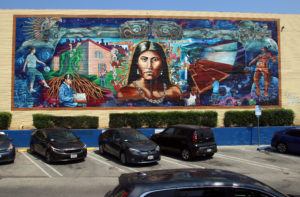
This mural, painted at a public housing complex in East L.A. in 2008, depicts Toypurina, a young Kizh woman who helped lead an Indigenous rebellion against the Spanish in 1785. Artwork by Raul González, Ricardo Estrada, and Joséph “Nuke” Montalvo. Photo by Mario Gershom Reyes
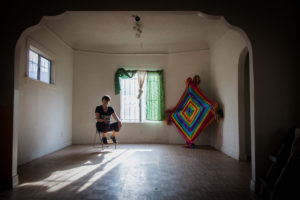
A woman prepares to leave her house in 2018. She was forced to move so that a new apartment building could be built on the site. Photo by Rafael Cardenas
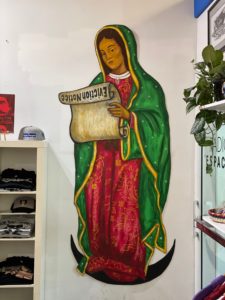
A public art piece by East L.A. artist Nico Avina shows the Virgen de Guadalupe—a symbol of Mexican identity—receiving an eviction notice, 2018. Artwork by Nico Avina
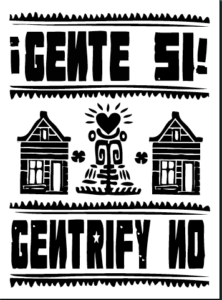
This artwork by East L.A. artist Nico Avina reads “People Yes!” in Spanish above “Gentrify No,” 2012. Artwork by Nico Avina
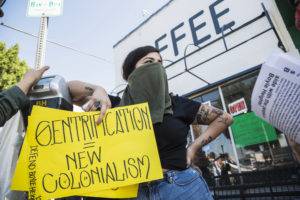
Activists protest gentrification in East LA, 2017. Photo by Ted Soqui © 2017 Los Angeles, CA.
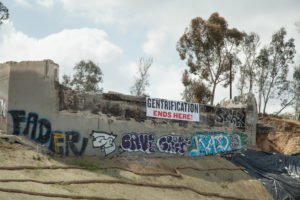
A sign and graffiti on the back of an old bridge that was demolished and rebuilt alongside a new neighborhood development, 2016. Photo by Rafael Cardenas
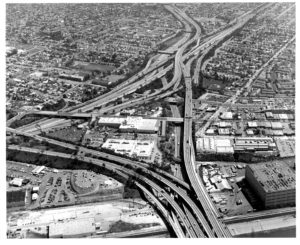
Freeways routed through East L.A. have forced thousands of people from their homes. These concrete crossroads impact the health and future of local residents. © California Department of Transportation, all rights reserved
Flipbook: The Boyle Heights Beat
EXPLORE THE BOYLE HEIGHTS BEAT
The Boyle Heights Beat is an independent, bilingual Spanish and English newspaper produced by young people from East L.A.’s Boyle Heights neighborhood.
All images courtesy of the Boyle Heights Beat. Graphic design for the print edition by Claudia Delgado.
Noticias por y para la comunidad / News by and for the community
The Boyle Heights Beat is staffed by teen reporters from local high schools. They portray their neighborhood as they know it—profiling unsung heroes, relaying regional history, and exploring debates about redevelopment, safety, and urban renewal.
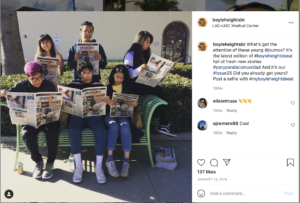
Reporters at the Boyle Heights Beat
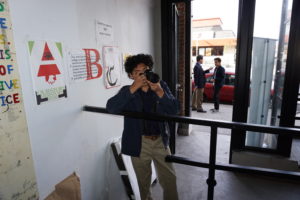
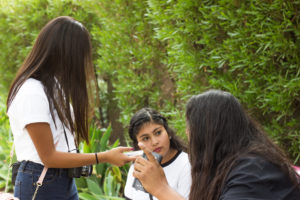
The newspaper’s staff includes photographers and reporters who conduct interviews with local residents.

As a high school junior, Brizette Castellanos reported on how the arrival of a chain store was impacting local independent businesses and neighbors (Photo/Gus Ruelas)
“The students have taught me what’s in this neighborhood. They have their own way of seeing the community. . . . Our reporters have a level of access, sensitivity and knowledge that is without equal.”
— Antonio Mejías-Rentas, editor, the Boyle Heights Beat
“Community members and organizations understand that change is inevitable, but they don’t want to see local businesses pushed out. Some local non-profits have formed collaborations to help support and preserve local businesses.”
— Xóchil Ramírez in the Boyle Heights Beat
Reported in “Uniting, Boyle Heights small businesses fight to stay” by Xóchil Ramírez (8/2/17)
“Redevelopment can be a scary thing, if whoever is developing does not have the interest of ensuring community access and housing for folks in the community.”
—Carla DePaz, East Los Angeles Community Corporation, reported in the Boyle Heights Beat
Reported in “Uniting, Boyle Heights small businesses fight to stay” by Xóchil Ramírez (8/2/17)
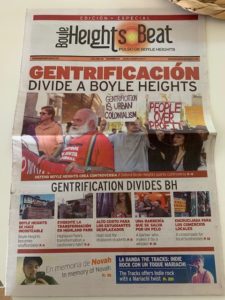
An issue of the Boyle Heights Beat from 2017, focusing on gentrification
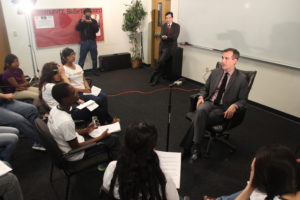
Reporters interview L.A. Mayor Eric Garcetti. Photo by Kris Kelley/Courtesy of Boyle Heights Beat
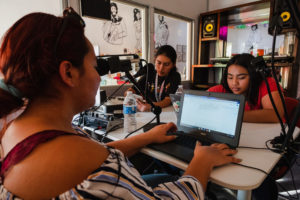
Samantha Soto, Noemí Pedraza, and Azucena Hilario work on Radio Pulso, the Boyle Heights Beat’s podcast. Photo by Kris Kelley, courtesy of Boyle Heights Beat
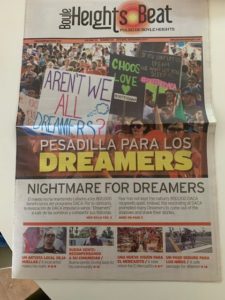
In 2017, the Boyle Heights Beat covered protests after the government rescinded the Deferred Action for Childhood Arrivals program (DACA). The program protected young undocumented immigrants, known as Dreamers, from being deported.
“Regardless of the current rhetoric, we share our border, we share our community, we share our geography, we share economies. The more we get to know each other, the better for both countries.”
—Rebeca Vargas, U.S.-Mexico Foundation, Dreamers without Borders, reported in the Boyle Heights Beat; Reported by Daniela Barranco in “Program helps ‘Dreamers’ reconnect with roots” (5/29/17)
“It was a very humbling experience to see the humble beginnings of my family. It brought me joy being able to see them, but it also brought me sadness that we left them. I understood better with my own eyes the reasons why my parents had to leave Mexico.”
—Alma, Dreamers without Borders participant, reported in the Boyle Heights Beat
Reported by Daniela Barranco in “Program helps ‘Dreamers’ reconnect with roots” (5/29/17)
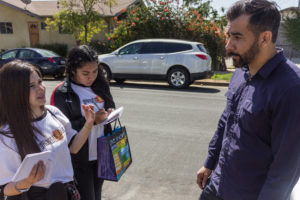
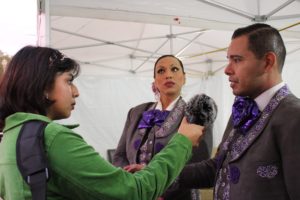
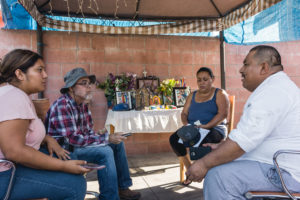

A flyer for one of the Boyle Heights Beat’s regular community meetings, organized to solicit community input
The Boyle Heights Beat was founded in 2010 by the USC Annenberg Center for Health Journalism.
It currently operates under the fiscal sponsorship of the nonprofit Social and Environmental Entrepreneurs.
Thanks to executive editor Kris Kelley Rivera and managing editor Antonio Mejías-Rentas for sharing this content.
Crossroads Story – Beringia
Shishmaref, Alaska, is an Iñupiat village of about 600 people on a barrier island near the Arctic Circle. Its residents are descended from semi-nomadic people who were forcibly resettled here by the U.S. government. Like many coastal villages, sea ice protected the island from the wind and waves, but warming temperatures are causing the ice to form later and later every year. This is accelerating coastal erosion, shrinking the island, and forcing residents to consider moving.

A resident of Shishmaref, Alaska, fishes for cod, 2020. Photo by Dennis Davis
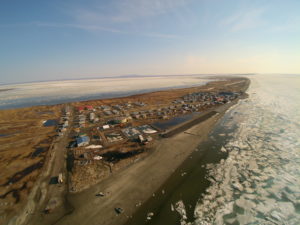
Shishmaref, Alaska, during a storm, 2020. Photo by Dennis Davis
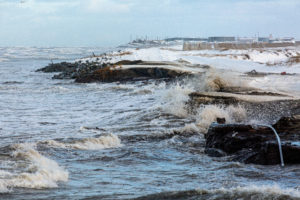
Unceasing waves continue to erode Shishmaref’s coastline, 2020. Photo by Dennis Davis